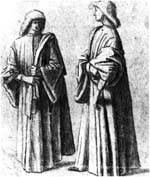 |
CARPACCIO, Vittore Figure Studies, detail 1490s |
"Two young togati . Although their sleeves look open-ended they are, in fact, a comeo, though pushed up to the elbow. Both wear bechi over the shoulder. The style of hair-cut of these two young men is typical of the early 1490s."[1] |
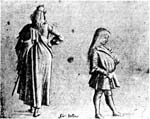 |
CARPACCIO, Vittore Study for figures in The Miracle of a Relic of the True Cross 1490s |
"Wrongly inscribed 'Gio. Bellini', the youth on the left is a study for one of the young men in Figure 26. The little boy wears the correct dress of the youth not yet accepted as a member of the government. The low-set belt, the curved effect of the torso and the style of the sleeve show the importance of fashion in Venice in the 1490s."[2] |
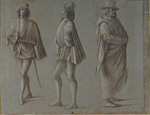 |
CARPACCIO, Vittore Recto: Sheet of Figure Studies |
|
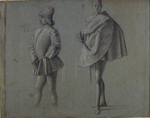 |
CARPACCIO, Vittore Verso: Sheet of Figure Studies |
|
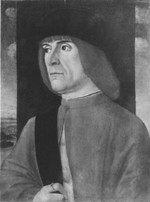 |
CARPACCIO, Vittore Portrait of a Man |
|
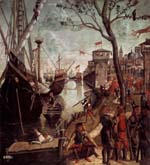 |
CARPACCIO, Vittore The Arrival of the Pilgrims in Cologne (from the Stories from the Life of St Ursula) September 1490 |
"On 16 November 1488 the Capitolo of the confraternity of Sant'Orsola imposed a special levy...to gather funds to...spend on the construction of the school or commision canvases depitcting episodes from the life of St Ursula...."[3] The order in which the canvases were completed, and the date at which the last was painted, is somewhat in doubt, but ranges from 1493 to 1500. The canvases were not completed in the chronological order of the story.[4] |
 |
CARPACCIO, Vittore Martyrdom of the Pilgrims and the Funeral of St Ursula (from the Stories from the Life of St Ursula) 1493 |
"Carpaccio was faced with at least one major problem in painting the Sant'Orsola series.... St Ursula, a princess of Cologne, was betrothed, according to legend, to a son of the English king. Carpaccio had no scruples about transplanting Ursula's family to Venice, as she was the heroine of the story, but the prince had, therefore, to be shown to belong to a different nationality. Whether Carpaccio was able to discover anything about English dress at the end of the fifteenth century would be impossible to ascertain but a close look at his paintings involving Englishmen reveals a certain type of large furry hat which he seems to have used exclusively to identify the English. In other respects their clothing is mildly German in style."[5] |
 |
CARPACCIO, Vittore Martyrdom of the Pilgrims and the Funeral of St Ursula (from the Stories from the Life of St Ursula), detail 1493 |
|
 |
CARPACCIO, Vittore Meeting of the Betrothed Couple and the Departure of the Pilgrims (from the Stories from the Life of St Ursula) 1495 |
|
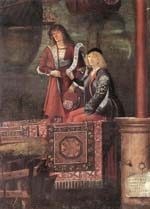 |
CARPACCIO, Vittore Meeting of the Betrothed Couple and the Departure of the Pilgrims (from the Stories from the Life of St Ursula), detail 1495 |
|
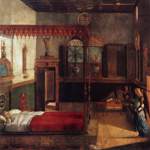 |
CARPACCIO, Vittore The Dream of St Ursula 1495 |
|
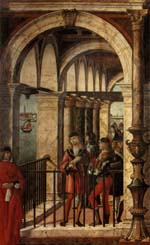 |
CARPACCIO, Vittore Arrival of the English Ambassadors (from the Stories from the Life of St Ursula), detail 1495-1500 |
|
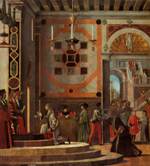 |
CARPACCIO, Vittore The Ambassadors Depart 1495-1500 |
|
 |
CARPACCIO, Vittore The Ambassadors Return to the English Court (from the Stories from the Life of St Ursula) 1495-1500 |
"When the Sant' Orsola series was being painted Venetian men, whether young and fashionable, gondoliers, or mature members of the government, wore small round caps; it is particularly by their hats or turbans that foreigners in Venetian settings are immediately recognisable. Among the crowd in the painting of the Return of the English Ambassadors stands a Greek, wearing an open gown and square-topped hard hat, an exact parallel to the clothes worn by the Greeks (or Armenians) in Gentile Bellini's Procession in the Piazza S. Marco. In another painting in the series a white-turbines black African stands on a bridge and a man with a short pointed beard and tilted red hat looks out at the spectator. His nationality would no doubt have been recognisable to a Venetian of the day and his well-trimmed beard along would suggest that he was not an Italian but more probably French. Close scrutiny of any of Carpaccio's paintings of Venetian crowds reveals white-bearded Turks, always a Greek or two and a variety of natives of the Near East and of the north coast of Africa, all very carefully observed and often repeated with slight but well-understood variations in their dress."[6] |
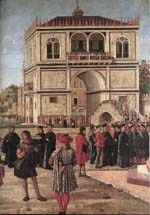 |
CARPACCIO, Vittore The Ambassadors Return to the English Court (from the Stories from the Life of St Ursula), detail 1495-1500 |
|
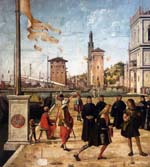 |
CARPACCIO, Vittore The Ambassadors Return to the English Court (from the Stories from the Life of St Ursula), detail 1495-1500 |
|
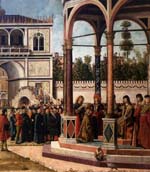 |
CARPACCIO, Vittore The Ambassadors Return to the English Court (from the Stories from the Life of St Ursula), detail 1495-1500 |
|
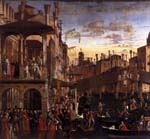 |
CARPACCIO, Vittore |
Part of a cycle about the relic of the True Cross commissioned by the Scuola di San Giovanni Evangelista in 1494 or 1495. See also works by Gentile Bellini, Giovanni Mansueti, Lazzaro Batiani and Benedetto Diana. "For this painting Carpaccio focuses on a mmiracle imputed to the relic, by which a possessed man was made whole by the patriarch of Grado, Francesco Querini, in 1494, as reported in the [Miracoli della croce] on the relic's miracles published in 1590."[7] |
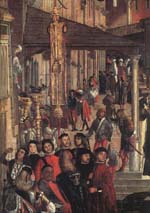 |
CARPACCIO, Vittore The Healing of the Possessed Man at the Rialto Bridge, detail c. 1496 |
Cesare Vecellio believed that "...one of the two young men on the left with their backs to the spectator in Carpaccio's Miracle of a Relic of the True Cross 1494 represented a member of a Company.... (I believe that the other young man also did.)"[8] |
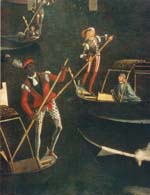 |
CARPACCIO, Vittore The Healing of the Possessed Man at the Rialto Bridge, detail c. 1496 |
"In works of art...Well-liveried gondoliers, certainly some if not all of them slaves, abound, and so do smart youths, sons, probably of prosperous artisans but almost indistinguishable in their dress, though not in their bearing, from their young patrician masters."[9] |
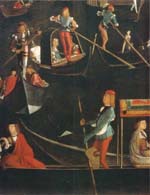 |
CARPACCIO, Vittore The Healing of the Possessed Man at the Rialto Bridge, detail c. 1496 |
|
 |
CARPACCIO, Vittore Holy Family with Two Donors 1505 |
|
 |
CARPACCIO, Vittore Figure Studies 1505? |
"The new outline for the male torso in about 1505. Both the fringe of hair across the forehead and the curved outline of the front of the torso of the 1490s have disappeared. (Note: the black patch below the chin does not represent a beard.)"[10] |
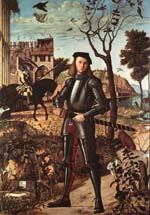 |
CARPACCIO, Vittore Portrait of a Knight 1510 |
|
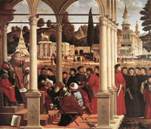 |
CARPACCIO, Vittore Disputation of St Stephen 1514 |
References
1. Stella Mary Newton, The Dress of the Venetians, 1495-1525 (Aldershot, England: Scolar Press: 1988), 10.
3. Stefania Mason, Carpaccio: The Major Pictorial Cycles , trans. Andrew Ellis, (Italy: Skira editore: 2000), 34.